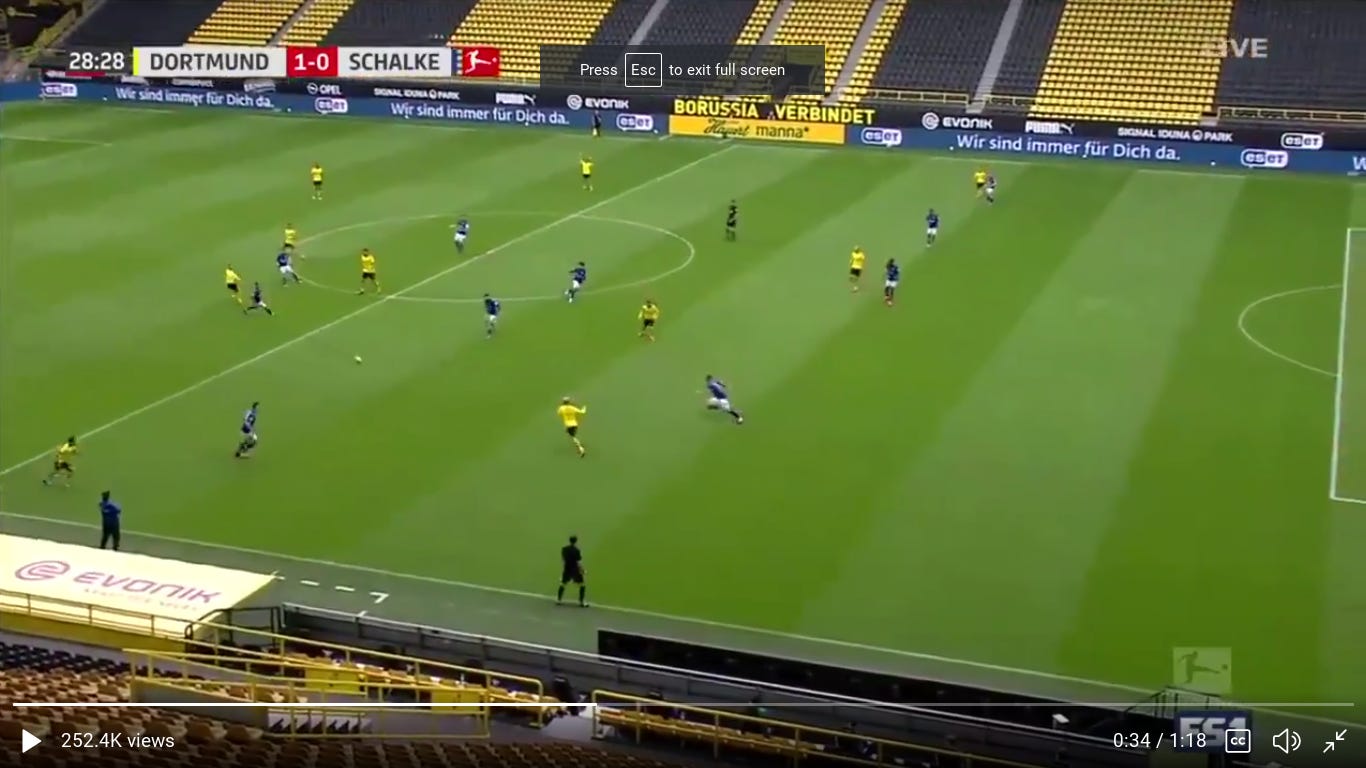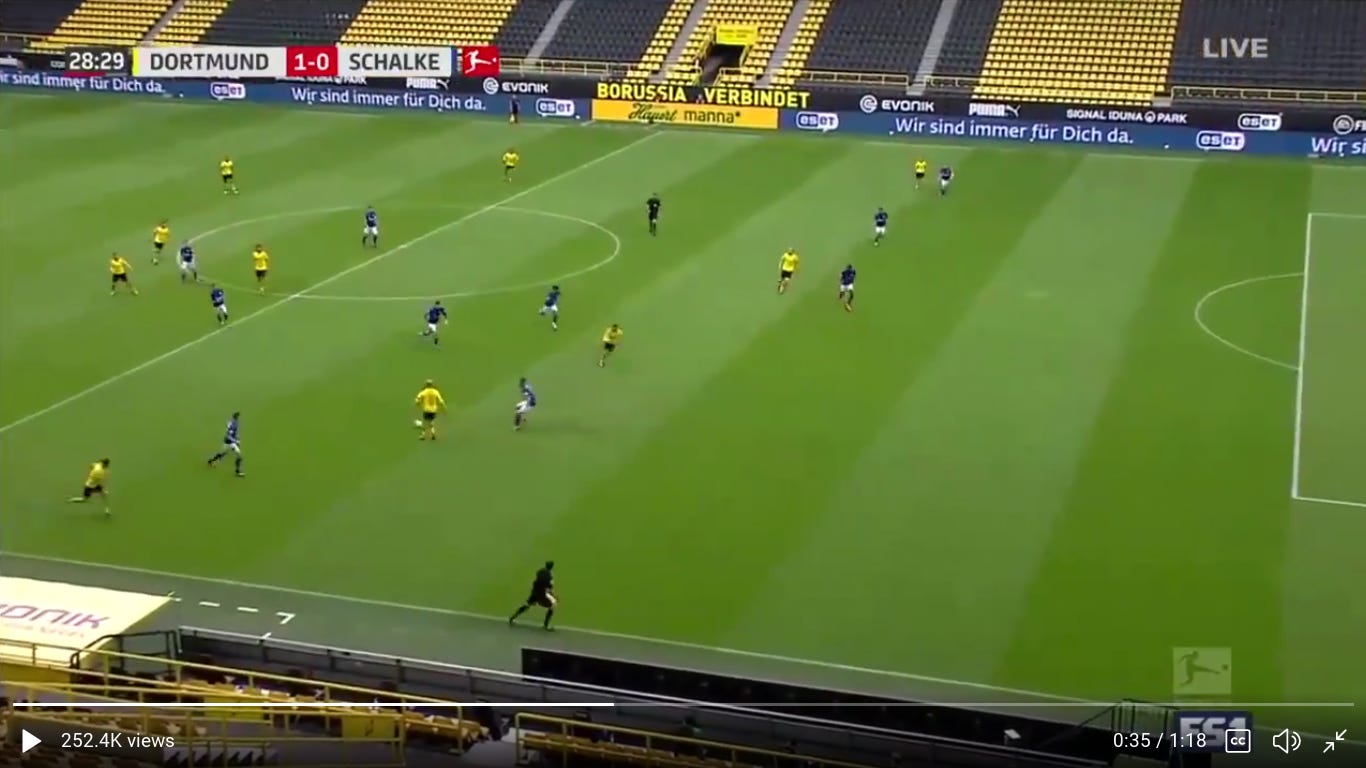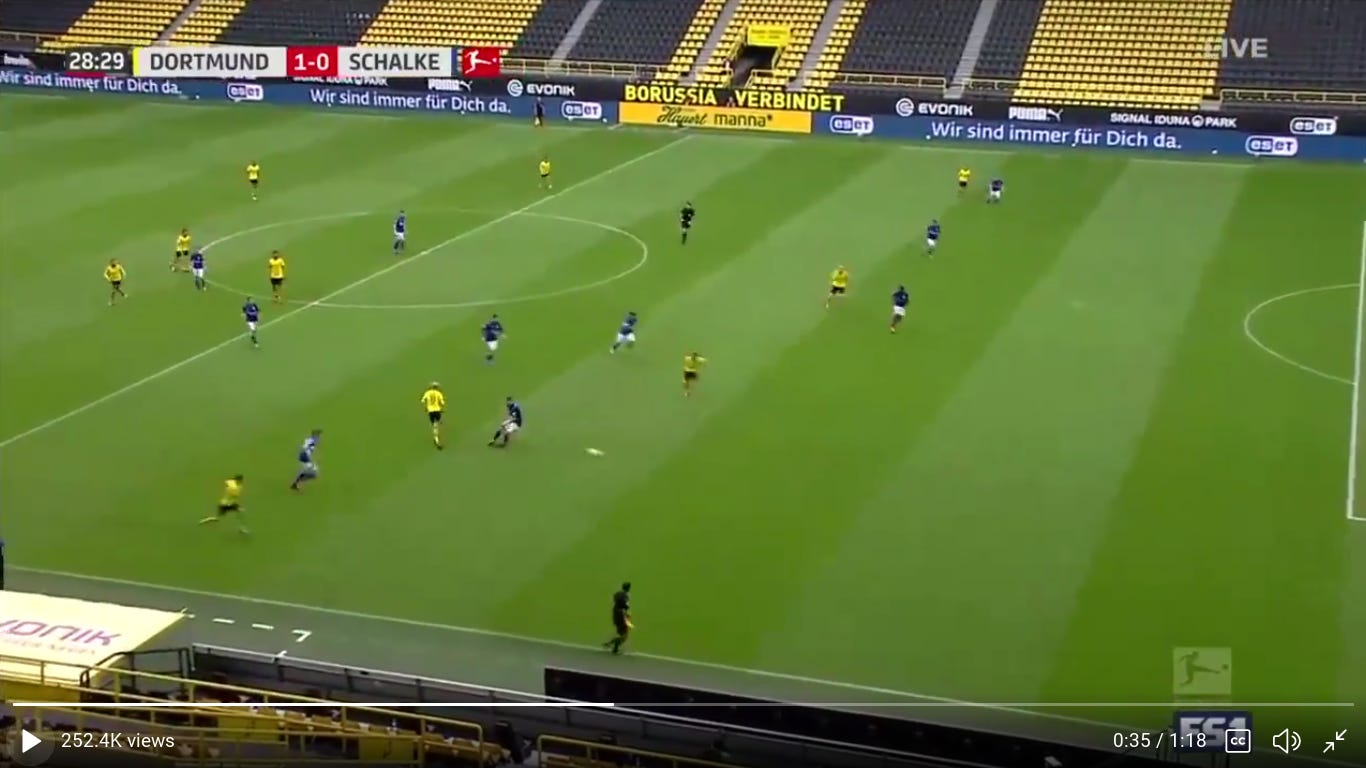Julian Brandt Eats Children
Or, what Jonathan Swift can teach us about Dortmund's first goal against Schalke on the weekend.
Hello. Do you have a moment to talk about our Lord and Savior, Julian Brandt’s heel?
For being away for two months, the Bundesliga provided us with some very good play on its return weekend, and more than a couple pretty goals. But this one, by far, was my favorite. And it was because of Julian Brandt.
Now, don’t get me wrong here. A lot of people do good things in this play. Lukasz Piszczek, bless him and his Zs, skips past the press and then breaks through Schalke’s rather static midfield line with the ball in to Brandt. The run from Thorgan Hazard and cross are both perfect. Haaland’s finish is perfunctory. The celebration is funny. It’s got everything you want from a fast, efficient, team-oriented goal. But let’s talk about subverting expectations, both in how it is good and how it is bad.
In 1729, Jonathan Swift anonymously published a pamphlet entitled, and get ready for this whole thing, “A Modest Proposal For preventing the Children of Poor People From being a Burthen to Their Parents or Country, and For making them Beneficial to the Publick,” more commonly known in your English literature class as “A Modest Proposal.” You might have read it somewhere along in your schooling as an example of satire, but to give you the long and the short of it, Swift was an Irish writer living in a time when life in Ireland was miserable and bleak, and England didn’t do much of anything to help the situation of its subjects, as it still ruled the island. Swift’s solution was to get as many eyeballs on the plight of Ireland as possible, and he did that by publishing a pamphlet suggesting that the Irish should eat their children. That is the Modest Proposal. If people in Ireland don’t want to starve, they should just eat their kids. It would save money and probably taste better than the gruel they’ve been subsisting off of.
“A Modest Proposal” was so successful then and is still read now because of its shock value and the way it subverts reader expectations. It begins with some standard bleeding heart moves, vividly depicting shocking poverty, squalor, and starvation. The next step a reader is expecting, obviously, is for some serious questions to be called of the government that allowed this to happen and perhaps a financial plan to get these people out of such dire straits. Nope! Swift says the people should eat their kids, and devotes a decent portion of the pamphlet detailing how one might actually prepare children the best for eating. It’s shocking, it’s funny, it’s sarcastic. Importantly, it also feels dangerous and new. When Swift subverts expectations, he is able to do so because his audience doesn’t see the twist coming. Which means there exists a separate universe where “A Modest Proposal” just sucks ass, and never gets read in any 21st century English courses, because Swift spent all his time writing about kids getting eaten, or otherwise telegraphed his writing style by way of overuse. Subversion works and can be great at tearing down standard structures and patterns that people adhere to, but it can also be overused. That’s when you get some we-live-in-a-society-ass, open-your-third-eye-blind-ass, message-over-medium bullshit.
Ok. Let’s talk about soccer.
Julian Brandt is the key to the goal above because he completes a pass that isn’t completed very often from this spot and angle. Even as the play develops and the runs begin to form behind him, in the moments when the backwards flick becomes increasingly more likely, I still didn’t think that ball was going to Hazard. I thought any back heel would go to Hakimi. And here’s why.

This ball is already traveling towards the corner flag and touchline. Hazard has become a pseudo-No. 10 in this position, dropping into the hole between Schalke’s back three and Weston McKennie. He and Brandt started the game as the players flanking Haaland in Dortmund’s 3-4-3 set-up, so Hazard creates a little positional havoc by overloading this side of Schalke’s defense. Piszczek beats the press and hits the ball in to Brandt, who has a lot of space, mostly because Achraf Hakimi has rockets attached to his boots, and Schalke is respecting that fact by having their own wingback mark him fairly far upfield. Looking at the way the ball is coming to Brandt, and having watched a lot of soccer, my first thought is that Brandt either takes a touch and looks to turn thanks to his runners pulling defenders away from him, or he dumps off a quick pass to one of the two Dortmund players in his vicinity, who will presumably check to him. IF he goes for the back-heel, and it’s still a capitalized IF here, I think it’s going to Hakimi. Why? Because the ball’s already going towards the touchline, where Hakimi can race onto it. Brandt doesn’t have to alter the path of the ball too much, just let it run through his legs and tap it to his left, which is the more natural motion for both ball and player, in my estimation.

That is not what Julian Brandt DOES. Hakimi races down the touchline, sure. But Hazard sees Nastasic in absolute no-man’s land, trying to challenge… something, I’m sure, and immediately gallops forward into the space on the wing, much closer to goal than Hakimi. The only player on Schalke that seems to know exactly what’s about to happen here is Weston McKennie, because when this ball gets within five feet of Brandt, he starts high-tailing it after Hazard’s run. The only problem is, he’s way too late to stop the inevitable from happening. A good flick of the heel is common enough in the modern game; in and of itself, it’s not a surprising move. But certain angles a player takes can still fool enough people on the field to place the ball in spots they don’t expect, subverting their expectations.

Bada bing, bada boom, Julian Brandt eats your babies.
Can we talk about the degree of difficulty here for a second? The flick with the outside of the foot isn’t an easy pass, and it’s definitely not an easy pass when you’ve got to hit a very precise angle, and it’s DEFINITELY NOT EASY when you also can’t rely on the ball’s own momentum to take it to the place you want it to go. It’s not a gentle tap with the inside of the foot towards Hakimi. He changes the angle of the pass drastically enough that he actually has to really give it some oomf, flicking his leg out and behind him as he runs forward, getting the ball to Hazard to run on to and the opportunity to put in a free cross. If the pass is any weaker at all, McKennie catches up to Hazard and muddies things up in the corner.
It’s not simply the concept of a back heel that does Schalke in. It’s the context and framework that Brandt completes it in. The combination of the vision to foresee an angle others do not, and then the ability to execute it, thereby subverting expectations of defenders and viewers who are accustomed to certain patterns and passes made in certain situations.
All that to say, it’s a beautiful goal. And one that gives me an excuse to use my English degrees.
And If You Like that Pass…
There have been several players throughout history that always seemed to be able to find the hidden angles no one else could see on the field, dissecting opposition with a pass they couldn’t see coming. Guti is probably my favorite player of this ilk.
The back heel to Zidane at 4:27 of that video is, to this day, one of the filthiest things I’ve ever seen a soccer player do in a real game.
A Quick Note From Me
You’ve probably noticed I’ve taken the last couple Sundays off from the newsletter, and I think that’s a trend that will continue to hold. It’s called Dead Ball Daily and I said it would be Daily-ish, but I think giving myself a day to take a break is both very beneficial to me and also to the quality of the newsletter. If something crazy happens, I might put one out on a Sunday or two. Cool? Cool.





